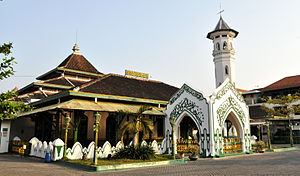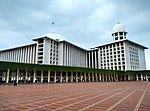Tajug
Islamic architecture elements

Tajug is a pyramidal or pyramid square (i.e. an equilateral square base with a peak) ornament which is usually used for sacred buildings in Southeast Asia including Indonesia, such as mosque or cupola graveyard. It is considered derived from Indian and Chinese architecture, which has history since pre-Islamic era, although there's also an element of an influence from Indian mosques.[1] The term tajug is also used to refer to mosques or surau (Islamic assembly building) in some regions of Indonesia.
See also
- Indonesian mosques
References
- ^ Architecturalized Asia: Mapping a Continent through History
- v
- t
- e
Islam in Indonesia
- Shia Islam
- Ahmadiyya
- Kejawèn
- Old divisions
- Abangan
- Priyayi
- Santri

| Civil society |
|
|---|---|
| Political parties | |
| Militia |
| Pre- independence |
|
|---|---|
| Post- independence |
- Islam Nusantara
- Islam Yes, Islamic Party No
- Islamic criminal law in Aceh
- Jama’ah Tabligh
- Jemaah Tarbiyah
- Modernist
- Traditionalist
- Mosques in Indonesia
- History of Indonesia
- National Heroes of Indonesia
 | This architectural element–related article is a stub. You can help Wikipedia by expanding it. |
- v
- t
- e














